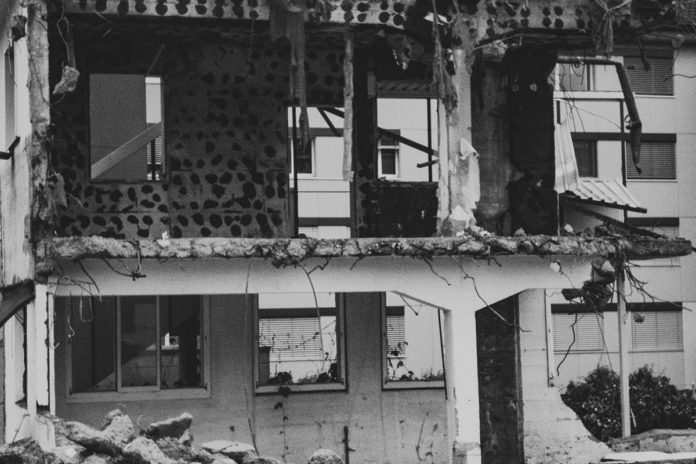
On Nov. 30, 2018, a large earthquake struck the Anchorage, Alaska region resulting in widespread infrastructure damage and business disruption. Over eight months later the recovery continues and resulting costs are still accumulating. Businesses and schools struggle to recover, some of which remain closed and will not reopen, and homeowners grapple with what it is, and is not, covered by earthquake insurance. While Anchorage, Alaska and Clark County, Washington are separated by 1,500 miles, we share a similar infrastructure inventory and a common earthquake risk that allow us to learn valuable lessons from their experiences.
Don’t forget the ceilings
Earthquake damage is typically thought of in terms of collapsed roofs, leaning walls and cracked foundations. While these types of structural damages did occur in Alaska, many more buildings suffered from damage to non-structural systems and building contents, such as collapsed ceilings, shedding of brick veneer, broken windows, toppled equipment and damaged inventory.
Several Anchorage-area buildings were structurally undamaged but resulting flooding from unbraced and damaged sprinkler lines forced all tenants to evacuate, some of which also experienced heavy content losses. Multiple Alaskan schools suffered minor structural damage but were forced to close, and remain closed, primarily as a consequence of non-structural damage, such as collapsed ceilings and lighting fixtures. A building’s seismic resiliency is firmly rooted in both its structural and non-structural systems. Unbraced ceilings, vulnerable sprinkler lines, improperly anchored brick veneer and unsecured building contents can be just as consequential as weak walls and roofs. Clark County building owners and occupants seeking greater business continuity following an earthquake would do well to examine the conditions of the non-structural systems in their buildings and proactively enact appropriate upgrades.
Terra Infirma
Some of the most widely publicized images from the Alaskan earthquake were those of fractured roads suffering the ill-effects of shifting soils. Soils-related damages to building foundations were also widespread, affecting commercial, institutional and residential structures. Some buildings founded on conventional foundations suffered little to no structural damage but sunk into poor soil under the vibrations of the earthquake motions. Other buildings founded on piling, driven through poor soil and founded into more reliable soil, remained structurally stable, but the collapse of the surrounding soil left the building several feet above the new, lowered ground surface. And if that wasn’t bad enough, the sinking soil also severed buried utilities, often leaving building occupants without sewer, water or electrical service.
Like non-structural systems within a building, the stability of the soil and the foundation system below the building are important. In Clark County we also have our fair share of poor soils, some of which can liquefy in an earthquake, temporarily rendering a building without soil support. Not sure if your building is situated over seismically-prone soils or if your building’s foundation system is ready for a larger earthquake? Talk to a local geotechnical engineer; Clark County and Portland are fortunate to be home to many qualified and experienced geotechnical engineers.
Should you have earthquake insurance?
Earthquake insurance is increasingly rare and difficult to obtain, but some insurers continue to offer these policies. Unlike property or casualty insurance with relatively low deductibles, earthquake insurance policies come with very high deductibles, often set at 20%, or more, of replacement value. A $500,000 home with “typical” earthquake-induced cracking is unlikely to require repairs valued at more than $100,000, meaning the owner is responsible for all of the repair costs.
With a few exceptions, many Alaskans were frustrated to find that their earthquake insurance covered little to none of the physical damage, even when the damage was confirmed by an engineer as attributable to the recent earthquake. Could Clark County homeowners and building owners find themselves in similar circumstances? Yes. But, keep in mind that the recent Alaskan earthquake was not the “big one.” One of the world’s largest earthquakes happened in Alaska in the 1960s; comparatively the recent Alaskan earthquake was much less powerful than the 1960s’ earthquake. The recent earthquake damage in Alaska was much less severe (modern building codes get some credit, too), and thus relatively few earthquake insurance deductibles were exceeded.
In Clark County our “big one” earthquake will come when the off-shore Cascadia Subduction zone slips again, generating an earthquake with ground shaking that will last not just seconds, like Alaska just experienced, but minutes. Many Clark County and surrounding area buildings will experience catastrophic damage, often well beyond 20% of replacement value, and likely beyond repair, especially those buildings built to older building codes and not seismically upgraded.
For those local property owners whose buildings suffer debilitating damage, earthquake insurance will be worth every penny, and then some. And while the Cascadia Subduction zone is primed to slip “soon,” the timing is unknown. Until then, probable Clark County earthquakes are unlikely to generate enough property damage to exceed 20% of the replacement value of damaged buildings. Should Clark County property owners invest in earthquake insurance? This question is best answered on a case-by-case basis that should account for a wide variety of factors, including the amount of equity in the building or home. However, if you do have earthquake insurance and a smaller earthquake strikes that causes damage, but not too much damage, remember that our Alaskan neighbors to the north feel your pain. And when the “big one” does come and you don’t have earthquake insurance, consider this to have been your warning.
HOW long can you be out of your building?
Perhaps the biggest impact of the Alaskan earthquake was the adverse business and economic impacts resulting from loss of building use. While your building or home may receive an initial “inspection” within the first few days following an earthquake, this is likely to be a quick (less than 30 minutes), exterior-only review, often not by an engineer, resulting in the building simply being “tagged” green (OK to enter), yellow (limited entry) or red (no entry). If your building is yellow- or red-tagged, your building use is curtailed or prohibited until an engineer confirms that the build is safe. Often a yellow- or red-tagged building can be deemed safe only after repairs are completed. How long will that take? The short answer for everyone is much longer than you’d like, and for occupants of seismically vulnerable buildings, usually too long.
Following a damage-inducing earthquake there will be an immediate surge in demand for, and resulting shortage of, construction labor, building materials and engineering services (keep in mind that the “big one” will also affect Portland, forcing Clark County to compete with our southern neighbors for these scarce resources). Even with outside resources entering the Clark County and Portland markets (watch out for unlicensed contractors), follow-up engineering inspections of damaged buildings will likely not occur for weeks, and perhaps months, after the earthquake.
While contractors can undertake short-term repairs soon after the earthquake, permanent structural repairs usually cannot proceed until an engineered set of repair plans have been prepared, a permit and a contractor are secured and the necessary materials are available. If you have earthquake insurance, it could take several months before you know if the repair costs are covered, as insurers scramble to handle the volume of claims. Most building owners have no choice but to wait for an insurance claim resolution before proceeding with the needed repair process, which could easily last three to 12 months once repairs actually begin.
Can you afford to be out of your building this long? Some Alaskans are learning the hard way that this is simply too long, and with no alternative building use available, have been forced out of business. Even if a business can recover and remain open, non-local competitors unaffected by an earthquake often steal market share. What can be done to minimize this risk? That, again, is a question to be answered on a case-by-case, but begins by understanding the ramifications of being out of your building, taking steps to minimize the consequences of a large earthquake and having a plan to continue operations away from your building, if needed.
Brandon Erickson, PE, SE, is a structural engineer and principal of Erickson Structural Consulting Engineers, PC, located in Vancouver. Erickson’s practice focuses upon assessment and rehabilitation of existing building structures, including seismic evaluations and upgrades. He has conducted multiple post-earthquake reconnaissance building inspections, including multiple inspection visits to Alaska following the recent earthquake. He can be reached at brandon@ericksonstructural.com and at 360-571-5577.


